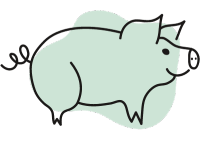
In the heartwarming world of animal companionship, pigs and dogs have been known to form remarkable bonds that bring joy to our lives.
Their interactions can be both entertaining and endearing, showcasing the unique personalities of each species.
But, while these stories warm our hearts, it’s essential to approach pig-dog interactions with care.
The American Mini Pig Association emphasizes that, despite some positive interactions, pigs and dogs can have unpredictable dynamics.
They advise never leaving a pig and dog together unsupervised, as unforeseen incidents can occur.
In this guide, you’ll get answers to common questions like “Do pigs and dogs get along?”, “Are pet pigs just like pet dogs?” and “How do I introduce my dog to my new piglet?”
How to Introduce Your Dog to Your New Pet Pig
To foster a safe and joyful environment for both pigs and dogs, we recommend sticking to the following guidelines:
Supervised Introductions: Always supervise initial interactions between your dog and new piglet. Monitor their behavior to ensure safety.
Positive Reinforcement: Use treats and praise to reward calm and friendly behavior during interactions, promoting positive associations.
Separate Spaces: To reduce potential conflicts, provide separate living spaces for pigs and dogs, allowing each to have its own territory.
Understanding Body Language: Learn to recognize the body language of both animals to anticipate and prevent any signs of aggression or discomfort.
- Never Leave Your Pig and Dog Together Unattended: Even if they seem to get along, their predator-prey dynamic can lead to fighting and harm.
Predator vs. Prey: Understanding the Differences Between Pigs and Dogs
At first glance, pigs and dogs might seem like they could be perfect playmates—both are intelligent, social animals that thrive in family environments.
However, their natural instincts and behaviors are vastly different beneath the surface, making their interactions complex and sometimes risky.
Understanding these differences is key to keeping both animals safe and happy.
Dogs Are Predators
Dogs are natural predators, bred for thousands of years to chase, hunt, and protect. Even the most well-trained and loving dog still carries these deep-rooted instincts.
Fast movements, high-pitched squeals, or sudden fear responses from a pig can trigger a dog’s prey drive, sometimes without warning.
This is especially dangerous for small or young pigs since their size and behavior can make them appear as prey in a dog’s eyes.
That’s why, no matter how well your pig and dog get along, they should never be left together unsupervised.
Pigs Are Prey
Pigs, on the other hand, are prey animals. Their instincts tell them to be cautious and defensive, which can lead to misunderstandings when interacting with dogs.
Pigs often communicate through body language and vocalizations that dogs may misinterpret.
For example, a pig rooting near a dog’s food or nudging for attention could be seen as a challenge rather than a friendly gesture. The situation can escalate quickly if a dog feels provoked or simply acts on instinct.
While it’s possible for pigs and dogs to develop a peaceful coexistence under careful supervision, it’s important to respect their natural instincts.
Responsible Pet Parents Should Always:
- provide separate spaces
- closely monitor their interactions
- never assume that past friendly behavior guarantees future safety.
By prioritizing their well-being and understanding their differences, you can create a safe and joyful environment for both your pig and dog.
Read this article to learn ways you can bond with your new piglet.
Herd vs. Pack: Pig + Dog Mentality and Understanding Hierarchy
Pigs and dogs may be highly social animals, but their approach to relationships, leadership, and social order is fundamentally different.
These differences can lead to misunderstandings between the two species and, if not managed properly, create problems in a shared home.
Pack Mentality: How Dogs Operate
Dogs are pack animals, meaning they naturally form structured groups with a clear hierarchy.
In a pack, there is typically a dominant leader (often called the “alpha”), and all other members fall into a ranking system beneath them.
This hierarchy is maintained through body language, vocalizations, and sometimes even dominance behaviors like resource guarding.
Dogs instinctively respect and challenge authority based on their perceived rank, and they expect other animals—including humans and other pets—to fit into this structure.
Because of this pack mentality, a dog may see a pig as either a subordinate or an intruder.
If the pig is smaller or timid, the dog might instinctively treat it as lower in rank.
Piglets Are Notorious Instigators
If the pig is assertive or tries to claim resources (such as food or bedding), a dog may perceive it as a challenge to its authority.
These natural instincts can create conflicts, especially if the dog attempts to assert dominance in a way that is aggressive or unsafe for the pig.
Herd Mentality: How Pigs Think
Pigs, unlike dogs, operate within a herd dynamic, which is more cooperative but still structured by a hierarchy.
In a pig herd, dominance is established through subtle behaviors like nudging, rooting, or even gentle pushing; however, this is unlike pack animals that rely on a strict leader-follower dynamic.
Pigs tend to have a more fluid social structure. Through daily interactions, they establish their own space and authority.
A pig in a home setting will naturally try to establish its place within the family “herd,” which includes humans and other pets.
This means they may challenge a dog’s position not because they’re aggressive but simply as part of their instinctual social order.
Suppose a pig asserts itself by taking a dog’s favorite spot, attempting to eat from the dog’s bowl, or engaging in pushy behavior. In that case, a dog might react defensively, leading to a dangerous situation.
Why These Differences Matter
The fundamental difference between pack and herd mentality means that pigs and dogs don’t “speak the same language” when it comes to social order.
A dog expects clear leadership and submission, while a pig expects a cooperative but assertive role within its herd.
This can lead to confusion, miscommunication, and potential conflicts, particularly when food, space, or affection from their human family is involved.
To keep both pets safe, it’s crucial to manage their interactions carefully.
Pigs and dogs should be introduced slowly and under supervision, with each having their own separate space to eat and rest.
Never assume that just because they tolerate each other today, they will always get along.
By understanding their natural instincts and respecting their differences, you can create a peaceful home where both animals feel secure and happy.
Conclusion: Creating a Safe and Happy Home for Pigs and Dogs
Pigs and dogs are both intelligent, social, and loving companions, but their differences in instincts, behavior, and social structures mean they require careful management when living together.
While heartwarming friendships can form, it’s important to remember that dogs have natural predatory instincts, and pigs have a unique herd mentality that doesn’t align with a dog’s pack-driven nature.
The key to a safe and happy home is supervision, boundaries, and respect for their differences.
- Never leave your pig and dog unsupervised together, no matter how well they seem to get along.
- Provide separate spaces for eating and resting, and always monitor their interactions closely.
Understanding their unique behaviors and needs will allow you to foster a peaceful environment where both pets can thrive.
With the right precautions and a deep respect for their instincts, you can enjoy the joy that both pigs and dogs bring into your life—while keeping them safe and happy along the way! 🐷❤️🐶
ADDITIONAL RESOURCES:
- Autumn Acres Min Pet Pigs – Autumn has a detailed YouTube Video about pig + dog dynamics.
- Facebook Groups – Getting in touch with other new pig parents is always helpful! There are a ton of new pig parents who get answered on Facebook all the time.







